Intel SSD 520 Review: Cherryville Brings Reliability to SandForce
by Anand Lal Shimpi on February 6, 2012 11:00 AM ESTRandom Read/Write Speed
The four corners of SSD performance are as follows: random read, random write, sequential read and sequential write speed. Random accesses are generally small in size, while sequential accesses tend to be larger and thus we have the four Iometer tests we use in all of our reviews.
Our first test writes 4KB in a completely random pattern over an 8GB space of the drive to simulate the sort of random access that you'd see on an OS drive (even this is more stressful than a normal desktop user would see). I perform three concurrent IOs and run the test for 3 minutes. The results reported are in average MB/s over the entire time. We use both standard pseudo randomly generated data for each write as well as fully random data to show you both the maximum and minimum performance offered by SandForce based drives in these tests. The average performance of SF drives will likely be somewhere in between the two values for each drive you see in the graphs. For an understanding of why this matters, read our original SandForce article.
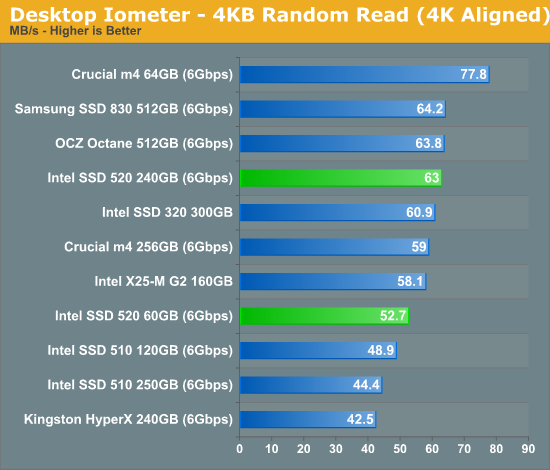
Random read performance seems to have topped out around 60MB/s for most drives and the 520 is no different here.
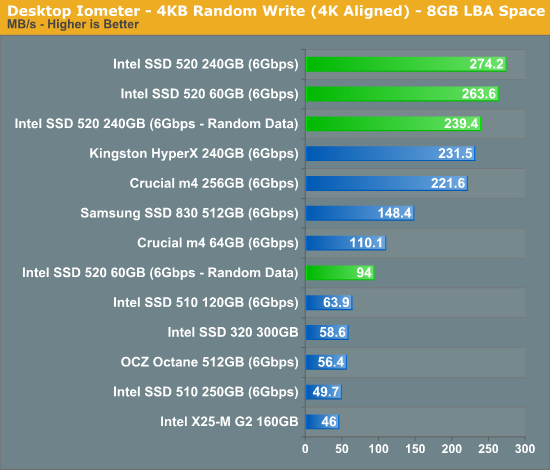
Random write performance, especially with highly compressible data sets the 520 performs beautifully - even outpacing the SF-2281 based Kingston HyperX.
Many of you have asked for random write performance at higher queue depths. What I have below is our 4KB random write test performed at a queue depth of 32 instead of 3. While the vast majority of desktop usage models experience queue depths of 0 - 5, higher depths are possible in heavy I/O (and multi-user) workloads:
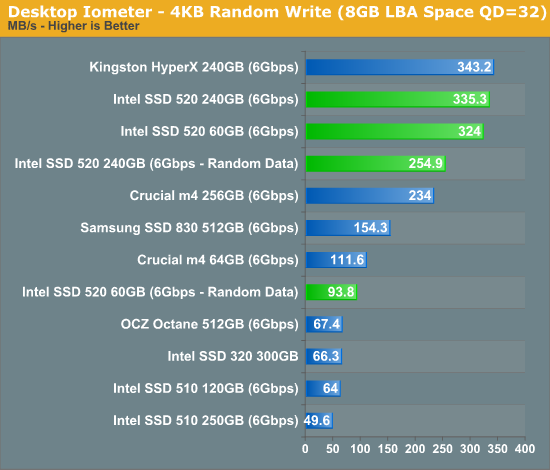
At higher queue depths the HyperX catches up to and surpassed the 520, perhaps indicating that Intel has done some work to optimize low queue depth performance on the 520 (likely what most end users will encounter).
Sequential Read/Write Speed
To measure sequential performance I ran a 1 minute long 128KB sequential test over the entire span of the drive at a queue depth of 1. The results reported are in average MB/s over the entire test length.
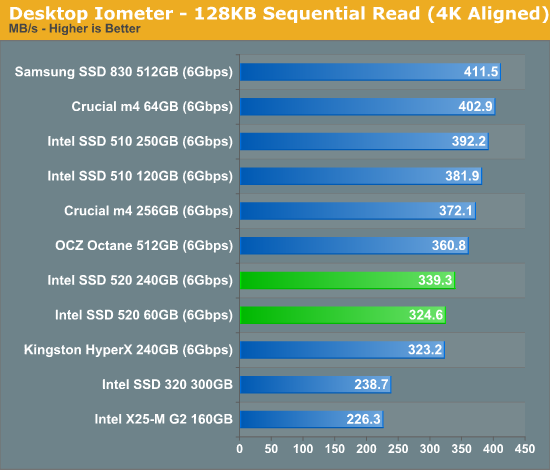
Sequential read performance is actually a bit lower than Intel's 510, but still higher than a standard SF-2281 drive.
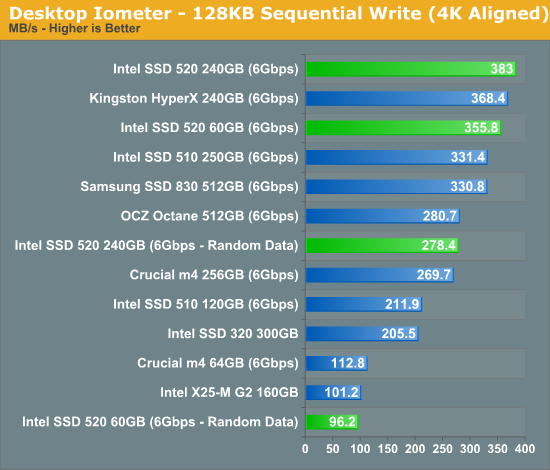
It's important to note just how close the 520's peak random write performance is to its sequential write performance. A big part of this is obviously that the SF-2281 is throwing away a lot of the data it has to write, but even if we compare incompressible 4KB random write to highly compressible 128KB sequential write we see a good ratio. The closer those two values are the more optimal the controller/firmware design is as, in theory, smaller random writes should be grouped to effectively become large sequential writes from the perspective of the NAND.










138 Comments
View All Comments
AnnoD - Monday, February 6, 2012 - link
Well I'm sorry, but... As positive as the conclusion is, to me this all sounds like Intel has found a way of hampering the competition. (I almost put "a new way" in that sentence instead, but I don't want to fire of wars...) How ethical is all this really? Is Intel putting effort into bugfixing itself, having SandForce doing the same work but with less manpower? Or are they actually not allowing to fix what Intel fixed for a while? I think this should not be so easily overlooked!quanstro - Monday, February 6, 2012 - link
i'm not sure how one could say that intel is morally obligated to give competitors the results of a year's testing. or that the competition has lost anything. if intel had not done the validation work, competitors would have exactly the same benefit from intel. would that also be stifling the competition?spazoid - Monday, February 6, 2012 - link
Do you expect Intel to give their findings and bug fixes away for free? Why would they do that? Do you have ANY examples of that happening outside of the open source community?Sunrise089 - Monday, February 6, 2012 - link
Yeah, I sure wish I had one fewer drive to chose from, especially if that one was the most reliable! All in the name of "fairness." ;)DanSmith - Tuesday, February 7, 2012 - link
Well thats how business works. Guessing you own a drive with a buggy SF controller from a competitor. Intel spent a year funded testing and bug fixing a controller they bought the rights to use so they get the benifit. Bet you OCZ have a similar deal but dont have the man power (or desire) to so thoroughly test.I know my time (and my companies downtime) is worth much more than the extra % for an SSD from a similar ilk as the x-25 and 320 series. As a sysadmin the thought of ever putting low cost consumer SSDs in production systems would keep me awake at night!
I will be getting a few of these to evaluate for sure.
Morg. - Tuesday, February 7, 2012 - link
You're (like anandtech) overrating Intel's edge w/ their firmware.At best they've got a few more resolved firmware issues than the default SF firmware.
Who cares ?
And most of all, who cares about a late and expensive third gen drive when the biggest issue with its direct competitors is that *some* of them cause problems.
Overall the 520 is a failure as a product and a resounding marketing success, as all of Intel's sponsored reviewers have an easy "real" story to tell. (like we had a 2281 that failed, put in the Intel one and boom it worked ... never tried another 2281, never tried another controller ... but who cares, let's buy overpriced intel)
seapeople - Tuesday, February 7, 2012 - link
Yes, it's a huge failure for a product to not only equal the fastest drives on the market today in performance, but to do so while besting them all in reliability and stability.Where's my sarcasm font?
MrSpadge - Monday, February 6, 2012 - link
Since it's ~50% higher on the Intel drive and the BSOD issues seem related to power management, I suspect Intel turned part of the power management off.MrS
coder543 - Tuesday, February 7, 2012 - link
yet somehow they aren't terribly power inefficient.Hauk - Monday, February 6, 2012 - link
Intel can you fix my OCZ Vertex 3 drives? They don't see to be as reliable as my old G2's..